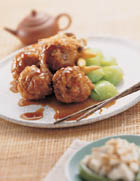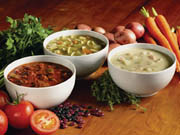
Industry currents have led food operators to stock menus with entrees and appetizers offering a little something for everybody. For some, that something is familiarity; others are seeking health and freshness, and even more people are stuck on variety and convenience. Those divergent desires can be “something else” for manufacturers. It may require manufacturers to source economically priced organic ingredients and provide authentic ethnic flavors, while keeping in mind the specific needs of the foodservice operator.
“One of the keys to success for foodservice operators is menu diversity and product variety,” says Frank Carpenito, president and CEO of Fairfield Farm Kitchens (Brockton, Mass.). On one hand, customers are seeking foods that remind them of safer, simpler times. On the other hand, “Restaurant goers continue to look for a more ethnic flair,” says Carpenito.
“In family dining, the kids will want something less intense in flavor, but the adults will want something a little more powerful,” discusses Robin Brooks, owner and CEO of Brooks Food Group (Bedford, Va.).
Brooks' company finds consumers are more comfortable trying a new dipping sauce as opposed to an entirely new entree. “A sauce gives them a little control, and it also lends itself to a broader range of people who would eat the product,” explains Brooks. “The operator will serve [a meat] with two or three sauces so that, flavor-wise, there can be something for anybody.”
Sauces also give the restaurant operator more flexibility in terms of variety. “Restaurateurs can change a sauce overnight, but it will take longer to change the marinade or a coating system for a manufactured chicken tender,” says Joanie Brown, director of research and development in process improvement at Brooks Food Group.
Marinades help with flavor and moisture retention. “You have to be aware that if you add marinades too heavily, it will change the texture of the meat,” warns Michael Janosik, CEC, executive research chef at Barber Foods (Portland, Maine).
Base flavors incorporated into the main meat element of an entree tend to be more subtle and, when paired with a variety of different dipping sauces, like pineapple mango or teriyaki ginger, the meat itself can be made to be more transferable in a lot of different geographical areas and regions. When restaurants change the sauce or stuffing in the chicken, people perceive it like a new entree, says Brown.

Something Old, Something New
Chefs are returning to classic dishes and preparation. A Barber Foods' client recently requested a duxelle, a classic dish using a reduction of pureed mushroom, shallots and herbs.Janosik believes the restaurant industry will turn toward simple and clean-tasting foods that are both comforting and adventuresome. “I think trying to have too many ingredients can muddle the flavors. Fusion is a neat trend, but I see chefs backing off and going toward a simpler, cleaner taste,” he observes.
Manufactured entrees and appetizers for foodservice must have a good first taste, as well as offer the possibility for a chef to add his own flair and customize the dish to his menu. Says Janosik, “I think you see variety and some of that [good, clean flavor] with the tapas menu. It creates a fun, interactive dining experience.”
The line between appetizer and main course has blurred so much that chicken wings, once considered solely an appetizer, have become part of the main course. Small plates are common in foodservice for many reasons, including presentation and reduced portion size for dieting, but their ability to provide variety also stokes the fires of demand. For example, patrons can sample several flavors of chicken wings with 13 signature sauces at Buffalo Wild Wings (Minneapolis). “Our operators have also requested jerk and Jamaican chicken wings,” says Brown. “The Buffalo flavor is huge, but it's not just Buffalo wings, but Buffalo fried shrimp, calamari, sandwiches, pizza and salads,” observes Maria Caranfa, who collects menu statistics for Menu Insights (Mintel International Group, Chicago).
Convenience also spurs customer spending on smaller entrees. Consumer attitudes suggest off-premise dining occasions will grow in the next several years, reports Technomic. “A lot of our customers are looking for portable foods,” agrees Brooks. They want something that can be picked up at the drive-through and consumed while driving, she adds. This trend will lead to a demand for fresh products that are made quickly, remain hot and hold up on the ride home.
Sometimes Ethnic
With better sourcing, chefs now have an opportunity to skew dishes more toward South American and Asian cuisines. For example, chipotle flavors are appearing in everything from burgers to mayonnaise, and from ranch dressing to aioli sauce. Dave & Buster's Inc. (Dallas) Honolulu menu supplies a Chipotle Salmon Salad, featuring chipotle-honey glazed salmon tossed with romaine lettuce, tortilla strips, cheese, avocado, pico de gallo and a chipotle dressing. The application of cilantro has become more common in dressings, sauces and creams; it could be an offshoot of an increase in Mexican cuisine.Experts predict chefs will go back to the basic foundations of preparing foods from Mexico or Asia. Many companies are sending chefs abroad to learn traditional flavors and dishes, as well as the modes of preparation. “If you have the opportunity, go right to the heart of the cuisine,” offers Janosik. “You're not going to learn any better than by doing that. There is a demand for more authentic Mexican foods--more like what you would find in a Mexican home rather than in casual restaurants.”
The Cuban croquette, a deep-fried meat mixture with a fine breading over it, is very popular in the Caribbean, Latin America and Miami. It is similar to a crab cake, but it has pork as well as chicken. Bison, like that served at Ted's Montana Grill (Glenview, Ill.), is another meat that does not frequent menus often, but has a certain following.
An increased Asian influence means more seafood. “Salmon is taking a back seat to ahi tuna, and tilapia is very popular as well,” says Caranfa. Bahama Breeze's (Darden Restaurants Inc., Orlando) fresh ahi tuna ceviche, served with citrus juices, shredded coconut, mangoes and crisp malanga chips, is an example of the rising popularity of ceviche, a popular Latin/Asian fusion dish. “Sushi is influencing entrees everywhere,” explains Caranfa.
According to Janosik, pho, a Vietnamese soup, has spiked in popularity in Northeastern cities with dense Asian populations. Pho can contain brisket, eye round steak, tripe or fatty flank with noodles and vegetables. Restaurants that are part of the Pho Hoa (Sacramento, Calif.) chain have been planted across the U.S. for more than 20 years. The chain recently opened five new franchises.
“Italian is stable because it is almost like a comfort food,” Janosik believes. “However, there are a lot of Italian foods that aren't being made that could be made.” For example, Italian-inspired ciabatta bread has become popular in chains like Big Boy Eateries (Warren, Mich.), which serves American-themed cuisine.
Flavor is not the only method to add variety to a menu. “We receive requests to create highly flavored appetizers and chicken items that have different shapes and sizes,” Brown contends. “Breaded products will be around because people like the crunch and texture,” offers Brooks. However, Brooks projects marinated chicken products will become more mainstream in the future. “A nice skinless, succulent piece of meat with good, strong flavor will be a future favorite,” she suggests. “People are thinking a little bit healthier today than they were before.” Nevertheless, she also agrees that dieting will not stop patrons from eating breaded products when they dine out. “Since most people don't have a deep fryer at home, they will enjoy these favorites in restaurants,” assures Brown.
“A lot can be done with texture, visual herbs and intense flavors when they are built throughout the product. Crunchy adds to the flavor. It is part of the experience. A good, strong coating also makes the appetizer portable,” states Brown, who has witnessed customers requesting more crunchiness.
Brooks and Brown have noticed that operators are searching for organic substrates and coatings, but the availability of organic ingredients is limited. It is more difficult to produce organic food because there are different controls in place for a strictly organic operation.
The top-rated appetizers, like chicken wings, onion rings and mozzarella sticks, have been around for a long time, and they will continue their popularity. However, some interesting new appetizers and accompaniments have set a fire under many chefs in the industry. “We are seeing an interest in vegetables prepared in such a way that they can be served in a QSR environment,” notes Brown. “We've noticed quite a bit of interest in sweet potato bites, corn products and buttermilk-flavored vegetables. Those are well received.”

Preparation Reputation
Some suggest there will be a shift in preparation away from frying and toward toasting, grilling and broiling. Grilling and roasting are the main preparation techniques at Seasons 52 (Orlando). Technomic also reports that all items on the Seasons 52 menu boast less than 475 calories.An entree can be microwaved, heated in a combination oven or “rethermed” in any number of different ways. It is important that manufacturers know the desired procedure before they begin formulating the product.
Being able to create consistent portion sizes is important in reducing economic losses. “We are seeing a lot of requests for sized chicken,” says Brooks. “New equipment can slice a chicken breast so it will cook in a predetermined amount of time,” explains Brown. This reduces the need for skilled labor and prevents overcooked meats.
Some foodservice manufacturers create plating guides so operators know how to cut a piece of meat for presentation. “In regard to presentation, height on a plate (i.e., stacked or stood on end) adds more dimension and is a fun way to present entrees,” says Janosik.
Soups and Sandwiches
According to Technomic, the bakery cafe, beverage and sandwich establishments are the fastest-growing LSR segments. The deli sandwich trend is moving into the LSR burger segment. Testimony to that trend is McDonald's (Oak Brook, Ill.) debut of “Oven Selects,” a toasted deli-style sandwich. Technomic predicts ethnic sandwiches such as Cuban, Vietnamese banh mi, Mexican tortas and Italian paninis will offer new sources for innovation.According to Mintel's Menu Insights, the option for heated sandwiches has increased slightly in the second quarter of 2005 when compared to the second quarter of 2004. Toasted, freshly baked, grilled, oven-baked, open-faced and hearth-baked are some of the preparation methods mentioned on menus in the last year. Claim Jumper Restaurants (Los Alamitos, Calif.) offers “Honey Chicken Brie,” a broiled Julienne chicken breast glazed with honey and served on crusty hearth-baked bread.
Soups fit right into the sandwich scenario, as evidenced by the Panera Bread (Richmond Heights, Mo.) and Bruegger's Bagel (Burlington, Vt.) chains, which have been successful at offering combinations of soups, salads and sandwiches. “Consumers are looking for great-tasting and nutritional soup products,” Carpenito finds. As Americans continue to be challenged by time crunches, soups are a quick (ready-to-serve) and nutritious alternative in foodservice.
Soup as a meal or as an accompaniment to a meal is a popular trend because, like bottled water and soft drinks, soups always are readily accessible, Carpenito finds. “There are very few foodservice operations that don't offer soup on their menus.” Although soup manufacturers offer as many as 60-70 varieties, Carpenito cautions that operators must make sure the variety they offer caters to what consumers really want. “It's important for a manufacturer to have depth and variety, but there are usually only five or six recipes that people regularly buy off the menu,” Carpenito suggests. “Variety aside, overall soup quality should be such that it tastes and looks as if it were just made by the restaurant's chef in the restaurant's own kitchen.”
Soups may sit in a kettle for as long as five hours, so manufacturers must create soups that best fit into a restaurant's operation. “It is important that the quality holds up, so that the customer who orders it at hour five gets the same quality as the person who orders it in the first hour,” says Carpenito.
For kitchen personnel, soups are a convenient, no-fuss item. In some cases, the product is boiled in a bag, slit open and kettled. Such conveniences minimize labor and the risk of making a mistake. Soup bases can be customized by adding ingredients such as cinnamon, cumin or another vegetable common to the menu. “There are a number of chefs that further enhance the soups we make by adding some type of creative garnish or by sprinkling additional lobster meat onto the product,” says Carpenito.
If a restaurant decides to serve five soups on the menu, depending on the geographical area, the restaurateur must find the right combination for that audience. For example, in Boston, a menu is remiss without New England clam chowder but, in the South, clam chowder might be replaced with gumbo. “Aside from offering great-tasting soups, balanced variety is the key. You don't want a soup menu that limits customers to the same two or three soups every day of the week,” says Carpenito. Comfortable variety, convenience and ethnic flair capture the essence of entree and appetizer trends that keep customers interested.
Sandwiches: Serving 'em Hot!
Sandwiches are really heating up--literally. Hot sandwiches are the largest growing trend in sandwiches, according to Mintel's Menu Insights. Hot sandwiches come in grinder, Panini, melt, submarine, hoagie, cheesesteak and plain sandwich styles.Top preparations for hot sandwiches include grilled, toasted, roasted, baked, melted, fried, breaded and sauteed. Chain restaurants such as Quizno's Subs (Denver) and Potbelly Sandwich Works (Chicago) have built their business on selling hot, toasted sandwiches.
Recently, Subway (Milford, Conn.) restaurant doubled its menu just by offering the hot preparation on all of their existing cold sandwiches.
--Maria Caranfa, Mintel's Menu Insights (Chicago)
Appetizers: The Crab Cake Movement
The crab is enjoying a great increase in popularity, thanks to the ever-evolving crab cake. According to Mintel's Menu Insights, the crab cake has experienced an 8% jump as an appetizer offering in casual chain and fine-dining establishments over the last year.The most popular crab cakes are created with Maryland, Dungeness, Blue, Louisiana, Maine and Jonah crab. More innovative crab varieties have been paired with such offerings as eggplant, sweet potatoes, angel hair pasta, lobster, crawfish, shrimp and cod to form distinct cakes.
Independent fine dining restaurants like Louis's at Pawleys (Pawley's Island, S.C.), along with casual chain restaurants such as Legal Seafood (Boston), favor mustard-flavored sauces to accompany crab cakes. Other fine dining restaurants prefer to match crab cakes with a sweet and spicy combination, such as orange-chili reduction and apple-horseradish remoulade at Anzu (San Francisco) and Ho-Ho-Kus Inn (Ho-Ho-Kus, N.J.). Andrea's (Metairie, La.) serves crab cakes with lemon butter sauces seasoned with the essence of basil and roasted garlic. Pappadeaux (Houston) is following the Caribbean trend by pairing their crab cakes with Mango Pineapple Salsa. The crab does not stand alone in the cake anymore.
Maria Caranfa, Mintel's Menu Insights (Chicago)
Entrees: Choose Your Meal
Restaurants are making it easier for the customer to choose multiple menu items for one price. Popular among barbecue restaurants for years, the “choose a meal” trend has exploded among casual and family/mid-scale restaurants. In February, Applebee's (Overland Park, Kan.) offered the promotion of “Three Course Combos.” The menu consisted of three themes: Italian, Cowboy and Southwestern. Within each of the themes, an appetizer, entree and dessert were offered for $11.99. Applebee's has added “choose a meal” to their permanent menu. In August, T.G.I. Friday's (Carrollton, Texas) began offering two three-course menus to choose from: “The Wild Side” and “The Mild Side.” The first menu is packed with spicy Southwestern flavors, while the second consists of milder Italian flavors. Denny's (Spartanburg, S.C.), Tony Roma's (Dallas) and Friendly's (Wilbraham, Mass.) also have adopted “choose a meal” options on their children's menus!
--Maria Caranfa, Mintel's Menu Insights (Chicago)
Links
- Mintel International Group's foodservice menu database
- Fairfield Farm Kitchens, makers of organic soups and entrees
- Brooks Food Group, custom developer of appetizers, entrees, snacks and desserts
- Barber Foods, manufacturer of chicken products
- Technomic Information Services: Executive summary proceedings from “Restaurants 2006: Trends and Directions--Report 11669”